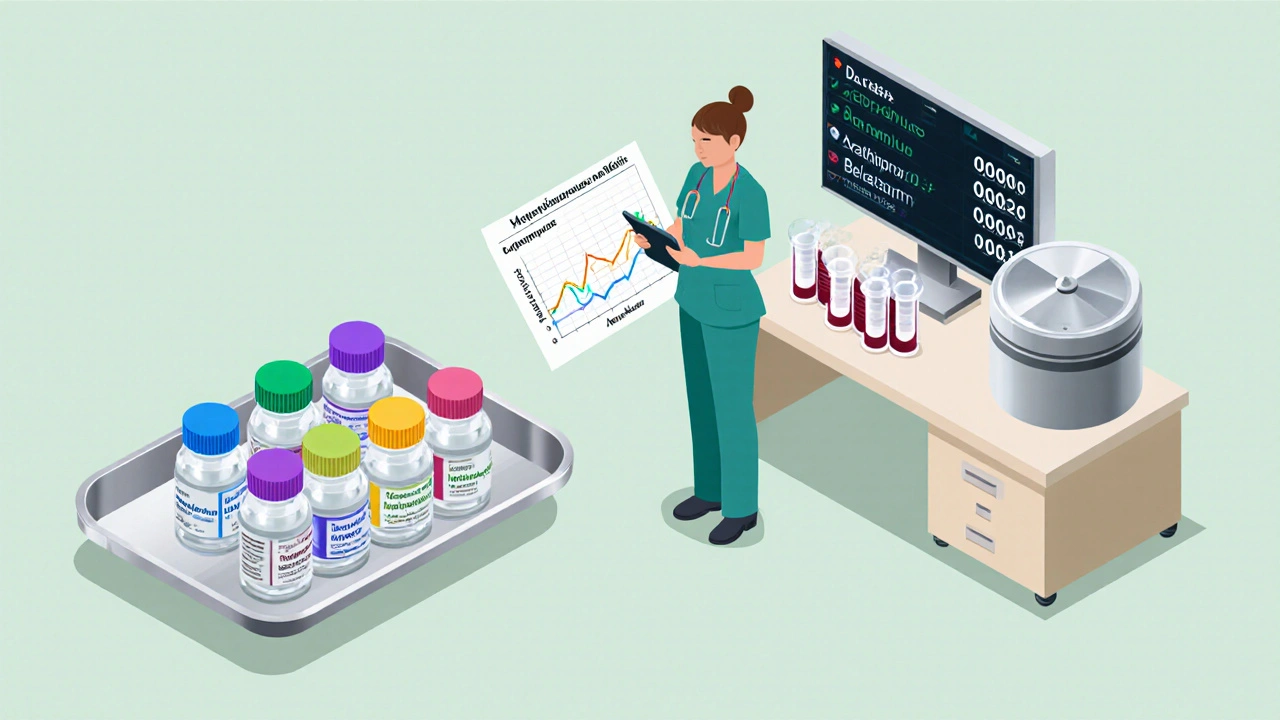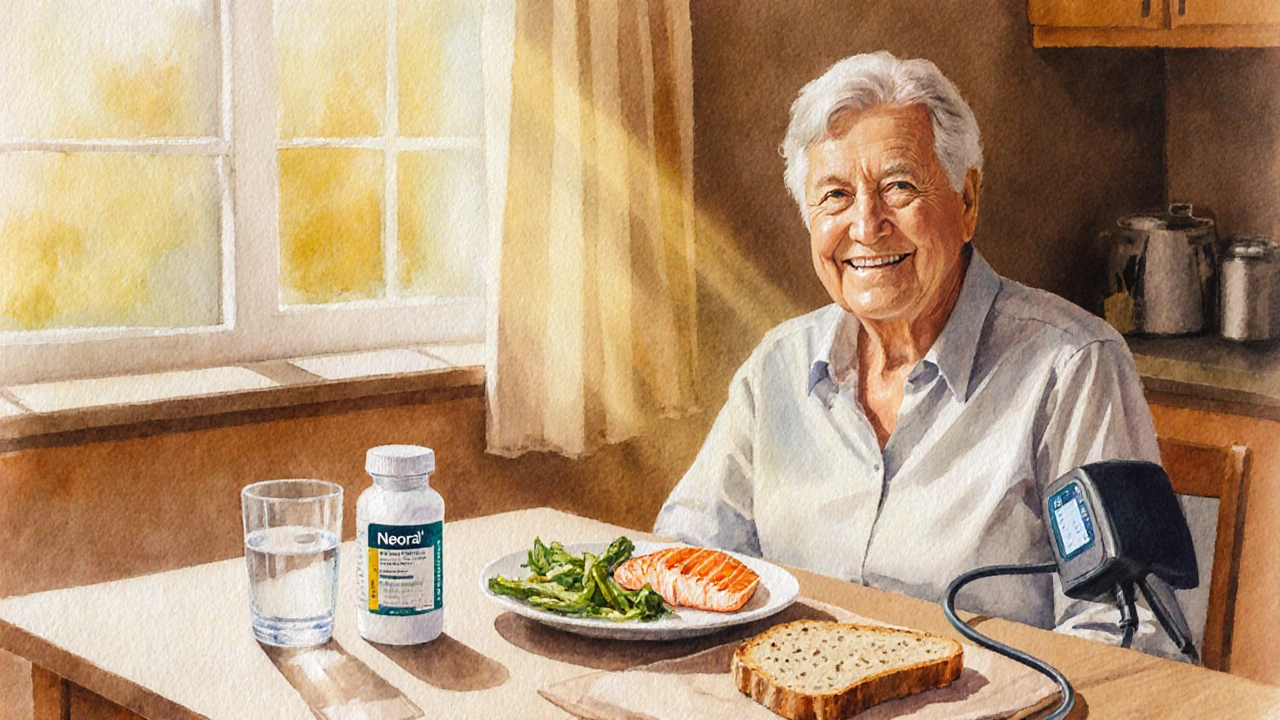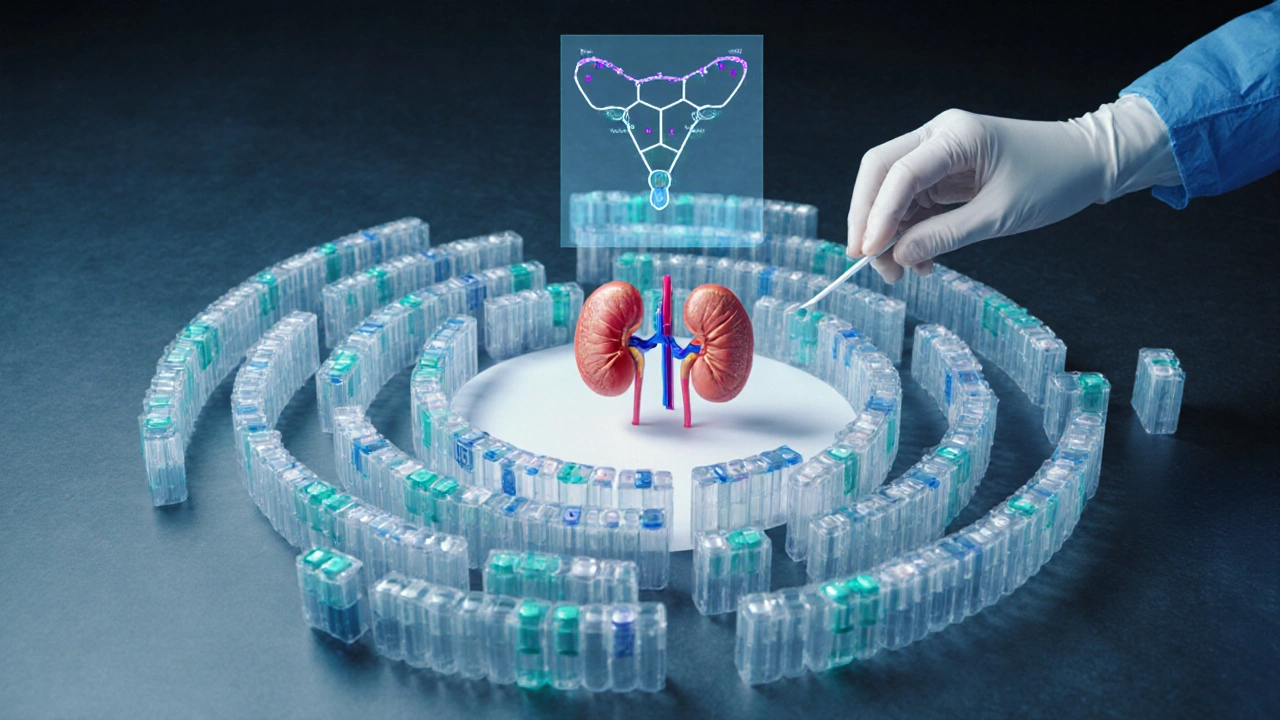When it comes to preventing organ rejection or managing severe autoimmune disorders, choosing the right immunosuppressant can feel like navigating a maze. Neoral is a widely prescribed brand of cyclosporine, but it isn’t the only option on the table. This guide walks you through how Neoral stacks up against the most common alternatives, so you can weigh efficacy, safety, and practicality before making a decision.
Quick Takeaways
- Neoral (cyclosporine) offers strong T‑cell inhibition but requires careful blood‑level monitoring.
- Tacrolimus (Prograf) is often favoured for kidney transplants due to a slightly better side‑effect profile.
- Mycophenolate mofetil (CellCept) works well in combination therapy and has fewer nephrotoxic concerns.
- Azathioprine is an older, inexpensive option but may be less potent for high‑risk patients.
- Sirolimus (Rapamune) and everolimus provide a different mechanism (mTOR inhibition) useful when calcineurin inhibitors cause toxicity.
What Is Neoral (Cyclosporine)?
Neoral is a brand formulation of cyclosporine, a calcineurin inhibitor that suppresses the immune system by blocking the activation of T‑lymphocytes. First approved in the early 1980s, it transformed organ‑transplant medicine by dramatically reducing acute rejection rates. Typical oral doses range from 3mg/kg to 6mg/kg daily, adjusted based on trough blood concentrations (usually 100-400ng/mL). Common side effects include nephrotoxicity, hypertension, gum hyperplasia, and tremor.
Key Alternatives at a Glance
Below are the main competitors you’ll encounter in transplant or rheumatology clinics.
- Tacrolimus (often marketed as Prograf) is another calcineurin inhibitor with a similar mechanism but a different side‑effect spectrum.
- Mycophenolate mofetil (CellCept) inhibits purine synthesis, targeting B‑ and T‑cell proliferation.
- Azathioprine is a purine analogue that interferes with DNA synthesis, used for decades in transplant maintenance.
- Sirolimus (Rapamune) blocks the mammalian target of rapamycin (mTOR) pathway, offering a non‑calcineurin approach.
- Everolimus is a newer mTOR inhibitor with a shorter half‑life than sirolimus.
- Belatacept is a selective costimulation blocker, administered via IV infusion.

How We Compare These Drugs
To help you decide, we look at five practical dimensions:
- Mechanism of action - What part of the immune cascade does the drug target?
- Typical dosing & administration - Oral vs. IV, daily vs. twice‑daily, loading doses.
- Efficacy in specific transplants - Kidney, liver, heart, and bone‑marrow outcomes.
- Safety and side‑effect profile - Nephrotoxicity, metabolic effects, infection risk.
- Monitoring requirements - Blood level checks, liver function, lipid panels.
Side‑by‑Side Comparison Table
| Drug | Mechanism | Typical Dose | Onset (hrs) | Major Side Effects | Monitoring |
|---|---|---|---|---|---|
| Neoral (Cyclosporine) | Calcineurin inhibition | 3‑6mg/kg daily (divided) | 2‑4 | Nephrotoxicity, hypertension, gum hyperplasia, tremor | Blood trough level 100‑400ng/mL; renal function |
| Tacrolimus | Calcineurin inhibition (more potent) | 0.1‑0.2mg/kg twice daily | 1‑3 | Nephrotoxicity, diabetes, neurotoxicity, tremor | Blood trough 5‑15ng/mL; glucose monitoring |
| Mycophenolate mofetil | Purine synthesis inhibition | 1‑1.5g twice daily | 24‑48 | Gastrointestinal upset, leukopenia, infection | CBC weekly for first month, then monthly |
| Azathioprine | Purine analogue (DNA synthesis) | 1‑2mg/kg daily | 48‑72 | Bone‑marrow suppression, hepatotoxicity, pancreatitis | CBC & liver enzymes every 1‑2weeks initially |
| Sirolimus | mTOR inhibition | 2‑5mg daily (target trough 5‑15ng/mL) | 4‑6 | Hyperlipidaemia, delayed wound healing, proteinuria | Blood level, lipid panel, renal function |
When Neoral Is the Preferred Choice
Neoral shines in situations where a clinician needs a drug with a long track record and proven efficacy, especially in high‑risk kidney and liver transplants. Its oral formulation is convenient for outpatient settings, and the ability to adjust dosing based on trough levels provides fine‑tuned control.
Patients with a history of severe diabetes may avoid tacrolimus, making Neoral a safer alternative. However, if a patient already has chronic kidney disease, the nephrotoxic potential of cyclosporine becomes a red flag, and switching to an mTOR inhibitor or mycophenolate might be wiser.

Scenarios Favoring the Alternatives
- Tacrolimus: Often the first‑line calcineurin inhibitor for kidney transplants due to slightly lower rates of acute rejection and a more favorable blood‑pressure profile.
- Mycophenolate mofetil: Ideal as a steroid‑sparing agent in combination regimens; its lack of nephrotoxicity makes it popular in liver transplant protocols.
- Azathioprine: Chosen when cost is a major concern or when patients cannot tolerate newer agents; frequently used in long‑term maintenance after the first year.
- Sirolimus / Everolimus: Useful when calcineurin‑inhibitor toxicity surfaces; also beneficial for patients with post‑transplant malignancy risk because mTOR blockers have anti‑cancer properties.
- Belatacept: Reserved for highly sensitised patients or those with severe renal impairment, as it avoids calcineurin‑related kidney damage.
Practical Tips for Patients on Neoral or Any Immunosuppressant
- Take the medication at the same time each day with a consistent amount of food; fatty meals can increase cyclosporine absorption.
- Never skip a dose. Missing doses raises rejection risk dramatically.
- Stay hydrated and monitor blood pressure regularly; hypertension is a common side effect.
- Report any new gum overgrowth, tremors, or unusual bruising to your healthcare team promptly.
- Bring a list of all medicines to appointments; many immunosuppressants interact with antibiotics, antifungals, and even certain herbal supplements.
Frequently Asked Questions
Is Neoral more effective than tacrolimus for kidney transplants?
Both drugs are highly effective, but large registry studies show tacrolimus has a modestly lower acute‑rejection rate. The choice often hinges on patient‑specific factors like diabetes risk or prior nephrotoxicity.
Can I switch from Neoral to mycophenolate without a wash‑out period?
Usually a brief overlap is recommended so the immune system stays covered. Your transplant team will taper the cyclosporine while starting mycophenolate, monitoring blood counts closely.
What foods should I avoid while taking Neoral?
High‑fat meals can boost cyclosporine absorption, leading to higher blood levels. Stick to moderate‑fat meals and keep your diet consistent from day to day.
Are generic cyclosporine formulations as safe as Neoral?
Generic versions contain the same active ingredient, but bio‑equivalence can vary. Some clinicians prefer Neoral for its predictable absorption, especially in transplant patients with narrow therapeutic windows.
How often will I need blood tests while on Neoral?
Initially, trough levels are checked twice weekly until stable, then every 1‑2months. Kidney function and blood pressure are monitored at each clinic visit.
Choosing the right immunosuppressant is a partnership between you, your transplant surgeon, and your pharmacist. By understanding how Neoral compares to its peers, you can ask better questions, track the right labs, and feel more confident about the path forward.


Scott Davis
October 12, 2025 AT 19:29Neoral works fine, but watch those blood levels.
Calvin Smith
October 13, 2025 AT 19:05Oh sure, because swapping one calcineurin inhibitor for another magically solves everything. Tacrolimus might look prettier on the pharmacy shelf, but its side‑effect list reads like a horror novel. If you’re willing to trade a bit of nephrotoxicity for a chance at diabetes, go ahead. Just remember the cost of those fancy brand names can burn a hole in your wallet faster than a rejection episode. Bottom line: no drug is a silver bullet, you just get to pick the one that hurts a little less.
Ashishkumar Jain
October 14, 2025 AT 18:42Hey folks, just wanted to say these meds are a real maze but you can definitely figure it out with the right doc. It’s definatly worth keeping a consistent routine and tracking any weird symptoms.
Gayatri Potdar
October 15, 2025 AT 18:19Look, the pharma giants want you to believe Neoral is the holy grail, but they hide the long‑term kidney damage behind glossy brochures. Every “new” alternative is just a re‑packaged version designed to keep you hooked on patents. If you can’t afford the brand, the generic might be just as risky, so don’t be fooled by the label. Keep your eyes peeled and demand real transparency.
Marcella Kennedy
October 16, 2025 AT 17:55Navigating immunosuppressants can feel overwhelming, especially when each drug comes with its own set of trade‑offs. The first thing I always suggest is to map out your personal health priorities before diving into the pharmacology. Are you more concerned about protecting kidney function, or is controlling blood pressure the bigger challenge for you? Do you have a history of diabetes that would make tacrolimus a less attractive option? These questions help you and your transplant team decide whether the potency of cyclosporine outweighs its nephrotoxic risk. In my experience, patients who stick to a strict medication schedule and maintain consistent meals see far fewer fluctuations in blood trough levels. Fatty meals, for instance, can boost cyclosporine absorption and push you into a toxic range without you realizing it. Setting a reminder on your phone and pairing the dose with the same type of breakfast each morning can make a huge difference. It’s also crucial to keep a detailed log of any side effects, from subtle tremors to gum overgrowth, and share it promptly with your healthcare provider. Regular monitoring of renal function and blood pressure isn’t just a bureaucratic step; it’s the safety net that catches problems before they become emergencies. If you notice rising creatinine or persistent hypertension, your doctor may consider switching you to an mTOR inhibitor like sirolimus, which spares the kidneys but comes with its own lipid‑management challenges. Combination therapy, such as pairing mycophenolate with a lower dose of cyclosporine, can also achieve the desired immunosuppression while minimizing the dose‑related toxicity. Don’t overlook the psychosocial support available-many transplant centers offer counseling, nutrition coaching, and peer groups that can help you stay on track. Remember, adherence isn’t just about taking a pill; it’s about embracing a lifestyle that supports graft survival. Keep your medication list up to date and review it with every new prescription, especially antibiotics or antifungals that can interact with calcineurin inhibitors. Finally, empower yourself with knowledge: ask about the therapeutic drug monitoring schedule, understand what the target trough levels mean, and never be afraid to request clarification if something sounds confusing.
Jamie Hogan
October 17, 2025 AT 17:32Neoral's pharmacokinetics are nuanced its dosing requires precision.
Ram Dwivedi
October 18, 2025 AT 17:09✅ When you start cyclosporine, keep your meal composition consistent – a steady amount of fat helps stabilize absorption. 📊 Regular trough level checks every two weeks until stable will save you headaches later. 🙏 And don’t forget to hydrate; good kidney perfusion can mitigate some nephrotoxic effects.
pooja shukla
October 19, 2025 AT 16:45India has its own affordable generics, and you don’t need the Western brand to survive.
Poonam Mali
October 20, 2025 AT 16:22While your step‑by‑step guide is heartwarming, the real‑world pharmacodynamics often diverge due to inter‑patient CYP3A4 variability, which you didn’t quite address. Moreover, the interplay between mTOR inhibition and lipid metabolism warrants a deeper dive beyond the superficial “watch your diet” advice. In short, clinicians need to employ therapeutic drug monitoring algorithms, not just patient anecdotes.
Alan Whittaker
October 21, 2025 AT 15:59Don't be fooled by the shiny packaging; the FDA’s “fast‑track” approvals are just a veil for profit‑driven trials that sidestep long‑term safety data. Every new tacrolimus formulation is secretly tested on a handful of volunteers, then pushed onto desperate patients.
Michael Waddington
October 22, 2025 AT 15:35Sure, but most patients don’t understand the impact of CYP450 inducers like rifampin, which can plummet cyclosporine levels to sub‑therapeutic ranges. You’ll want to educate them that even over‑the‑counter herbal supplements can throw the whole monitoring plan off balance.
HAMZA JAAN
October 23, 2025 AT 15:12Exactly, the supplement angle is often the silent killer in transplant outcomes.
Julie Sook-Man Chan
October 24, 2025 AT 14:49Totally agree, keeping an eye on those labs is the cornerstone of safe therapy.
Amanda Mooney
October 25, 2025 AT 14:25Indeed, consistency in dosing and vigilant symptom tracking are paramount for optimal graft survival.
Mandie Scrivens
October 26, 2025 AT 14:02Grammar check: “Neoral’s” vs “Neorals” – because apparently every pharmacist thinks punctuation is optional.
byron thierry
October 27, 2025 AT 13:39While the comparative analysis presented herein is thorough, one might also consider the economic implications of long‑term therapy, particularly in low‑resource settings where brand‑name cyclosporine may be prohibitively expensive.
April Rios
October 28, 2025 AT 13:15Let’s not forget that the immunologic milieu is also shaped by patient genetics; HLA matching still trumps the choice of any single immunosuppressant.